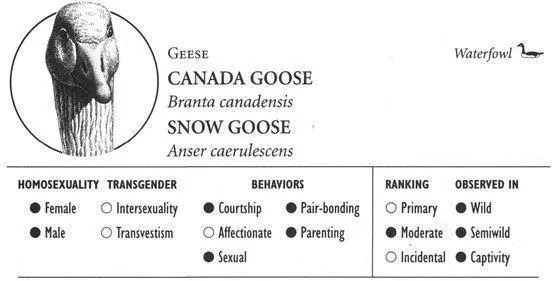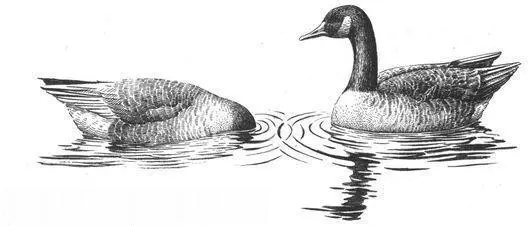Although most gander pairs are stable partnerships, occasionally one or both birds may behave antagonistically toward his partner. Fights sometimes erupt when one male tries to mount the other, while occasionally the aggression aimed at an intruder is turned back on one of the partners. Bonded ganders (especially in trios) may also become “jealous” of the attentions their partner shows toward another bird. Some gander pairs are incestuous, as brothers may form long-term homosexual bonds. In addition, interspecies same-sex pairs also occur, for example between Greylag Geese and Mute Swans. Like Greylag-only gander pairs, these partnerships are long-lasting and distinguish themselves by their aggressiveness, with the two males frequently defending their territory against intruders.
Frequency: Homosexual couples constitute a significant proportion of pairs in Greylag Geese: an average of 14 percent of pairs in some populations are same-sex, and in some years this proportion can be even higher, with more than 20 percent of all pair-bonds consisting of ganders.
Orientation: Some Greylag males in gander pairs are exclusively homosexual, since they remain in a monogamous same-sex pair-bond for their entire lives (or re-pair with another gander on the death of their partner). Other males, however, are bisexual: some copulate with a female while remaining primarily bonded to a male (as described above), while others are involved in bisexual trios. Still other males alternate or switch between female and male partners over their lives—for example, ganders in heterosexual pairs sometimes find a male partner after the death of their mate. More than half of all widowers re-pair with a bird of the opposite sex, less than a third remain single, while the remainder form homosexual bonds.
Nonreproductive and Alternative Heterosexualities
Several variations on the monogamous, lifelong pair-bond occur in this species. Divorce occasionally happens: in some populations as many as a quarter of all females, for example, may abandon their mates and find a new gander, and overall, 5–8 percent of pairs divorce. Greylag Geese also sometimes form polygamous heterosexual trios, in which bonding occurs primarily between birds of the opposite sex—two males with a female or, more rarely, two females with a male. In addition, some families foster-parent chicks by combining broods with another family, while widowed ganders occasionally adopt goslings. Birds in heterosexual pairs may engage in promiscuous courtship and mating. Ganders sometimes try to mount females other than their mate, while females may pursue other males—much to the consternation of their mates, who often try to physically prevent them from engaging in “extramarital” activities. Although Greylag Geese become sexually mature in their third year, some one-year-olds form pair-bonds and even engage in courtship and sexual activity long before they begin breeding. Like homosexual pairs, heterosexual associations may also occur between related birds (especially parent-offspring), or birds of different species (e.g., with Canada Geese). However, sibling pairings are much less common among birds of the opposite sex.
Sources
*asterisked references discuss homosexuality/transgender
Ens, B. J., S. Choudhury, and J. M. Black (1996) “Mate Fidelity and Divorce in Monogamous Birds.” In J. M. Black, ed., Partnerships in Birds: The Study of Monogamy , pp. 344–401. Oxford: Oxford University Press.
Huber, R. (1988) “Sex-Specific Behavior in Greylag Geese, Anser anser L.” Texas Journal of Science 40:107–9.
*Huber, R., and M. Martys (1993) “Male-Male Pairs in Greylag Geese ( Anser anser).” Journal für Ornithologie 134:155-64.
*Lorenz, K. (1991) Here Am I—Where Are You? The Behavior of the Greylag Goose. New York: Harcourt Brace Jovanovich.
*———(1979) The Year of the Greylag Goose . New York: Harcourt Brace Jovanovich.
Olsson, H. (1978) “Probable Polygamy in the Greylag Goose, Anser anser, and an Instance of Combined Broods.” Vår Fågelvårld 37:257–58.
*Schönfeld, M. (1985) “Beitrag zur Biologie der Schwane: ‘Männchenpaar’ zwischen Graugans und Hock-erschwan [Contribution to the Biology of Swans: ‘Male Pairing’ Between a Greylag Goose and a Mute Swan].” Der Falke 32:208.

CANADA GOOSE
IDENTIFICATION: A brown-plumaged goose with a distinctive black neck and white cheek patch; varies widely in size, from 2–24 pounds. DISTRIBUTION: Mostly throughout North Amerca. HABITAT: Lakes, rivers, marshes, meadows, and tundra. STUDY AREAS: Horicon Marsh Wildlife Refuge, Wisconsin; Holkham Park, England; in captivity in Ithaca, New York; subspecies B.c. interior, the Hudson Bay Canada Goose, and B.c. canadensis, the Atlantic Canada Goose.
SNOW GOOSE
IDENTIFICATION: A pinkish-red-billed goose with two major color phases: all-white and “blue” (grayish plumage with a white head and neck). DISTRIBUTION: Alaska and north-central Canada, northwestern Greenland; winters in southern United States and northern Mexico. HABITAT: Tundra, marshes, floodlands. STUDY AREAS: La Pérouse Bay, Churchill, Manitoba, Canada; Carver Park, Minnesota; subspecies A.c. caerulescens, the Lesser Snow Goose.
Social Organization
Snow Geese are extremely gregarious and nest in dense colonies that can number in the thousands of birds; Canada Goose breeding grounds are generally less dense. In both species, birds usually pair in long-term, monogamous bonds (albeit with a number of variations—see below), and outside of the mating season they gather in large flocks.
Description:
Behavioral Expression: In Canada Geese, two birds of the same sex sometimes form a pair-bond. Both male and female homosexual pairs occur, and the partners may be either adults or juveniles; homosexual pair-bonds often persist for many years (as do heterosexual ones). Courtship behavior in the form of HEAD-DIPPING is frequently a part of such bonds: in this display, one bird ritually splashes water over the back of its head and neck by dipping its head deep into the water and then lifting it back up. In heterosexual contexts, this is often a prelude to copulation, but homosexual copulation is not a prominent feature of same-sex pairs. One exception involves trios: occasionally a bond forms between three birds—two females and one male—and sometimes one of the females will mount and copulate with the other female. Some lesbian pairs try to raise a family: one female in a homosexual pair, for example, built a nest and laid eggs while her partner stood guard, then the other female built her own nest next to the first and also laid eggs. None of the eggs hatched, however, because the females constantly rolled the eggs (which were probably not fertile in any case) back and forth between their nests and broke all of them.
Courtship between a pair of female Canada Geese: the “head-dipping” display

More successful lesbian parenting occurs in Snow Geese. Pair-bonds between females are strong: when one member of the pair is absent from her mate, the other begins loudly calling to her until she returns. The pair builds a single nest in which each female lays eggs; as a result, such nests may have SUPERNORMAL CLUTCHES containing double the number of eggs found in heterosexual nests (8 eggs versus 4–5). Both birds take turns incubating the eggs (in heterosexual pairs, the male does not incubate). Since one or both females sometimes copulate with males, some of their eggs may be fertile. When they hatch, both females raise the goslings, including defending them against intruders and predators (such as Herring Gulls) by standing over them with cupped wings. Male homosexual pairs are not found in Snow Geese, although occasionally a cross-species pairing does develop between a male Snow Goose and a male Canada Goose. The two birds become constant companions, following one another and roosting close together, although nest-building and copulation do not usually take place. However, same-sex mounting does sometimes occur between male Snow Geese who take part in heterosexual “gang rapes.” In this species, males often sexually harass females, chasing them and forcing them to copulate. In some cases, other males gather together in large “spectator” groups—sometimes containing as many as 20–80 males—to watch and perhaps even join in. Occasionally, one male mounts another male as part of the group sexual activity that ensues.
Читать дальше














